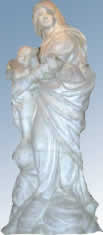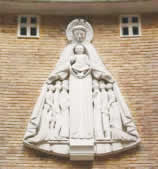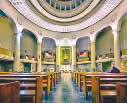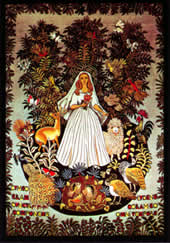Notre Dame de France
Leicester Square, London.
Place of refuge and worship.
by the Editor
 Hidden amid the theatres and thronging crowds of Leicester Square, London, is a Church which is a landmark building and a centre of ministry by the Marist Fathers and their associates.
Hidden amid the theatres and thronging crowds of Leicester Square, London, is a Church which is a landmark building and a centre of ministry by the Marist Fathers and their associates.
It is the main French language church for the city, but caters for all-comers in a variety of ways. It has a Refugee Centre and a listening room with trained staff.
It had its origins in the 19th century when Cardinal Wiseman (1802-1865) established ‘national parishes’ for ethnic minorities who flocked to the city seeking work. He asked the Marist Fathers known for their work at Spitalfields to take up the ministry to the French workers. With the aid of a large donation from Empress Eugenie, the church was constructed all in iron under the architect Louis Auguste Boileau, its circular shape reflecting the original use of the site as a rotunda ‘Panorama of Burwood’, which was the forerunner of the cinema. The mission had a little hospital, an orphanage, and a school staffed by the Sisters of Vincent de Paul.
The Church took a new lease of life during World War II when London became a rallying point for the free French, although the Church was destroyed in 1940 during the Battle of Britain. The statue of Our Lady of Victories was destroyed, but the head was recovered and remarkably parachuted back into France in 1942. The original sculptor, Henri Vallette, resculpted a copy using the dimensions of the original head. It was shipped back to England in January 1945.
 A stone from Chartres Cathedral was laid and blessed for a completely new complex on 31 May 1953. It was inaugurated on 6 October 1955 by Cardinal Veltin, archbishop of Paris. In the 1950s its activities broadened and much artwork was added. In the 1960s The Centre Charles Peguy established nearby, moved to the premises next door, now called Maison Pierre Chanel, 16 Leicester Square where the intellectual life of French immigrants and the spiritual needs of a considerable number of French “au pair” girls were cared for. During this time significant numbers of francophone immigrants from Mauritius used to meet at the Church.
A stone from Chartres Cathedral was laid and blessed for a completely new complex on 31 May 1953. It was inaugurated on 6 October 1955 by Cardinal Veltin, archbishop of Paris. In the 1950s its activities broadened and much artwork was added. In the 1960s The Centre Charles Peguy established nearby, moved to the premises next door, now called Maison Pierre Chanel, 16 Leicester Square where the intellectual life of French immigrants and the spiritual needs of a considerable number of French “au pair” girls were cared for. During this time significant numbers of francophone immigrants from Mauritius used to meet at the Church.
The French Marist Fathers departed in 1987 but were welcomed back in 1992. In 1996 when they returned as an international team, they set up the Notre Dame Refugee Centre which is now located at Maison Pierre Chanel, helping the asylum seekers and refugees who are frequently destitute, and providing advocacy services, advice and a place to gather.
On June 1st 2008 the new Marist province of Europe took responsibility for the French church as a project and appointed an international French-speaking Community. This had in fact been the reality for some years as fluent French speakers from Ireland, England, the USA and elsewhere had worked there in the several ministries associated with the Mission.
The Church in fact has a number of pieces of quality French art provided mostly by the School Beaux Arts organised by Hector Corfiato in Paris. The stunning tapestry behind the altar is the work of a French Benedictine monk Robert de Chaunac (1907–1997). French poet and writer Jean Cocteau worked in the church in November 1959. His murals have two themes: The Annunciation of Mary, and the Crucifixion.
The whole complex is a remarkable building. A circular interior church nave with a sky-light, with the administration and community apartments built around the walls. The ‘tower’ is a residence for young people sharing community with the Fathers and engaged with them in the Church’s mission. It is on the North side and access can be gained from the roof which resembles the hanging gardens of Babylon, and is a wonderful spot for quiet reading, or at night to observe the frequent film premieres in the Square below.
---------------------------------------------------
The New Eve Tapestry
(Front Cover)
This tapestry hangs over the main altar at Notre Dame de France church Leicester Square London. It is the work of a French Benedictine monk Dom Robert de Chaunac. It measures 5.4 m x 4m and was made in Aubusson France in 1954.
The subject is the ‘New Eve’, one of the titles by which we honour Mary, and is based on a verse from the book of Proverbs quoted in Latin at the bottom of the tapestry:
“Cum eo eram cuncta componens Ludens coram eo omni tempore”:
“I was by his side like a master craftsman ever at play in his presence.”
This fresh young girl advancing towards us is the new Eve; Mary through her ‘Yes’ at the Annunciation allows God to fulfil his plan of redemption in the person of Jesus. It is a restoration of God’s plan for humanity. The new Covenant affects the whole of Creation, as the tapestry suggests with its abundance of plants and the presence of animals.

 Entries(RSS)
Entries(RSS)